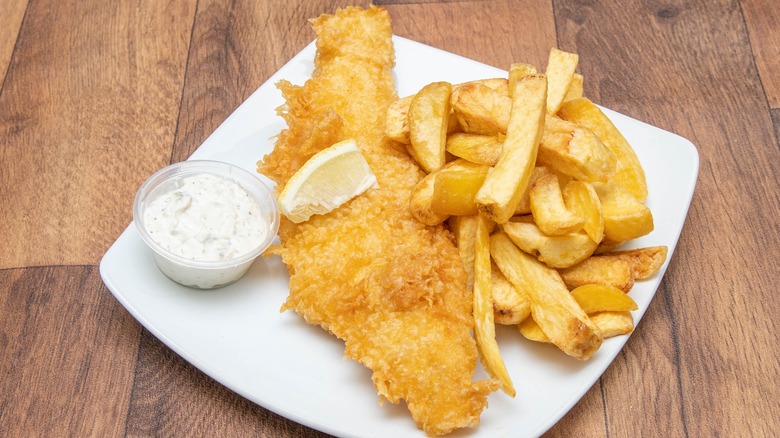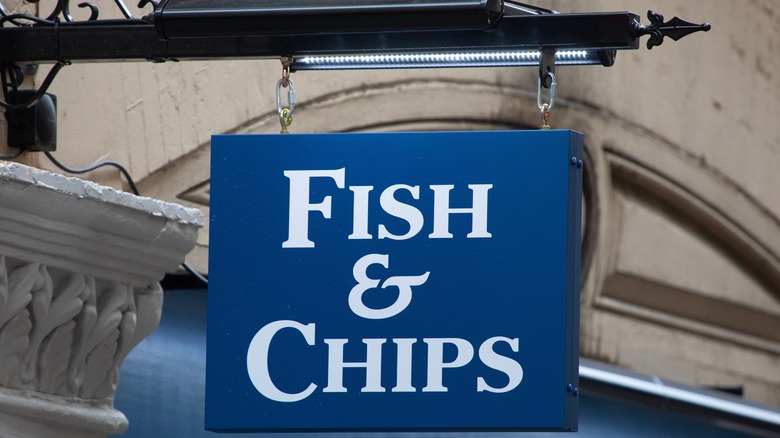How Fish And Chips Became Britain's Defining Street Food
Many countries have an emblematic street food, like tacos in Mexico or ramen in Japan. For Britain, that dish is fish and chips. Its appeal is understandable; there's undeniable allure to a white-flaked fish dipped into a crunchy batter, and served with thickly-cut fried potatoes. As a complement to such a hearty meal, expect a serving of mushy peas, some variant of vinegar, and tartar sauce.
Due to its present popularity, it's hard to imagine a time when fish and chips didn't feature on multiple menus. Yet, the meal has a surprisingly modern history that traces to varying groups of immigrant cuisine. The fried fish portion is attributed to Sephardic Jew refugees, who brought the dish to England during the 15th century. Meanwhile, the spud — a New World food — arrived in fried form centuries later.
It was only in the mid-19th century that the fated pair united, and it hasn't lost popularity since. Fish and chips now serves as an excellent symbol for British cuisine, intertwining immigration, industrialization, and a comforting appeal that hits the spot for many.
Fish and chips first came together during the 1860s
Although the combo wouldn't take hold for decades, the roots of fish and chips took hold in the 15th century. Fleeing religious persecution on the Iberian peninsula, Jewish settlers brought along the practice of frying cod and haddock in flour or matzo meal. It's said that the technique emerged for preservation, so that the fish could be eaten a day later on Friday Sabbath. Soon after, these creations made their way on sale, as cooks perfected the best way to batter fried fish. The use of flour and beer kicked off during this time, and remains the batter employed today.
The arrival of chips to England is more uncertain, although appears to have hailed from across the English Channel. Fries are contentiously attributed to either France or Belgium, so some suggest French protestants brought the food over in the 17th century. However, spuds had already arrived from the New World to British shores by the late 1500s.
The first convergence of fish and chips is unknown. Many cite that Joseph Malin, a Jewish immigrant, opened the original shop in the early 1860s. While others believe the dish first appeared in Northern England roughly during the same time. By 1865, fish and chips eateries had become documented and they only grew in popularity from there. Tartar sauce was also invented around this time, and mushy peas didn't become part of the mix until the 20th century, so the dish kept evolving into new forms.
The combo grew to peak popularity in the early 20th century
At first, fish and chips eateries were small-scale establishments, sometimes even run from home kitchens. However, as the industrial revolution transitioned into more metropolitan life at the end of the 19th century, the dish fed in greater numbers. More effective methods of fishing took hold, matched with more efficient distribution of fish to urban centers. The dish even expanded past street food, with restaurateurs opening table service renditions of fish and chips.
The street food reached an all time peak during the 1920s, where there were an estimated 35,000 shops open in the U.K., a number about three times today's count. In fact, fish and chips eateries remained open through both World Wars, offering comfort without inclusion in rations. Even George Orwell noted the dish's wide appeal in print.
Later into the 20th century, fish and chips lost some dominance, perhaps due to the expansion of other affordable options. With its highly international nature, the United Kingdom now hosts a range of other street food offerings, from dumplings to döner. Not to mention fast foods, like McDonald's Filet-O-Fish (which has its own documentary-worthy history), compete in the same marketplace. Yet, fish and chips remains a national favorite, suggesting its crunchy appeal will never fully fade.


